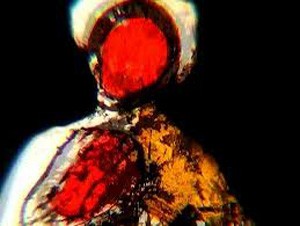Banner images L to R: Image is Virus, courtesy Dalibor Martinis; Checkmate and Painted in the Air, both courtesy NFD
Searching for Balance (Hledání rovnováhy)
Petr Skala, Czech Republic, 1973, silent, digital file from 16 mm, 3 minutes
Prophecy (Věštba)
Petr Skala, Czech Republic, 1980, digital file from 16 mm, 2 minutes

Still from Searching for Balance, courtesy NFA
Petr Skala (b. 1947) is a founding father of Czech postwar experimental film, though his work remained unknown even to his close friends until the mid-1980s.[2] Along with Radek Pilař, he is also one of the pioneers of video art in the Czech Republic. Trained at Prague’s Film and TV School of the Academy of Performing Arts (the famed FAMU), Skala graduated in 1975 and for more than a decade worked as a documentary filmmaker, though he had trouble finding stable employment, having being deemed “unreliable” by the regime. Working under unfavorable circumstances, he was constrained but not deterred by censorship and self-censorship from writing and directing the films he wanted to make (in addition to directing promotional films and a variety of radio programs to make money).
Not satisfied internally by this work, however, Skala led a parallel life from 1967, when he began to experiment with the techniques available for creating purely abstract, camera-less films by hand on 16 mm film. He engraved, scratched, drew, painted, and applied heat and chemicals to both raw and exposed film stock. He also built his own optical printer and used everyday substances to conduct amateur chemical experiments on the surface of film emulsion. Working in this way, he produced during the Czechoslovak “normalization” of the 1970s “experiments with the film medium [that] stemmed from his . . . need to give shape to his inward visions and . . . explore new alternatives of artistic expression."[3] Notably, he did so in complete solitude and obscurity. The first public screenings of his films—attended predominantly by a small circle of friends—were held only in the second half of the 1980s, after restrictions on such events had eased and Skala had been accidentally exposed to the work of other experimental filmmakers through an Austrian TV signal that could be received in southern Bohemia.

Still from Prophecy, courtesy NFA
Skala believes that his films should be seen in the context of one another and as part of an oeuvre, which is why both of his films shown in the present series are discussed here in a single entry. His earliest work was purely abstract and black and white. Searching for Balance dates to the year when Skala shifted to working exclusively with color, which he applied to the film stock before then manipulating it. It also represents the moment when Skala began to introduce a particular figurative image—that of a female torso—into his films, though here, it still remains unrecognizable at times.
Prophecy shows Skala integrating the image of the female torso much more with the abstract patterns both inside and outside it in an effort, as Bohdana Kerbachová puts it, to “embrace the unity and interdependence of all phenomena connected with man’s finding of his place in the universe."[4] This film also reflects a change in Skala’s working methods that came after he began to illegally use the equipment of Czechoslovak Television to color electronically footage that was originally made on heavily altered black-and-white film stock. Skala thus turned video into an aid, inventing out of aesthetic need a method that video artists elsewhere, unknown to him, were also exploring.
Prophecy also presents a good example of Skala’s use of minimal musical scores and of his longstanding interest in visualizing the relationships between the microcosmic—in this case, structures that resemble cells—and the macrocosmic—that is, the human body that appears as a universe of changing biomorphic forms. Both films also show Skala’s lifelong tendency to create variations on a visual theme in his films. To create dynamism, the themes are developed through a twofold approach that combines spontaneity and premeditation: Skala makes individual frames in a gestural, automatist way but organizes them methodically like a music score according to preset lengths of time that each shot should take up, speeding up or slowing down the footage as necessary. Such a structure emphasizes repetition and cyclicality in the film—qualities that are central to Skala’s larger belief about the way the universe works.
In 1982, Skala began working, again in isolation, with video as an independent artistic medium. He encountered works of video art from other countries in the mid-1980s, which is also when, following the first public screenings of his films, he met Radek Pilař. Pilař was an artist and fellow experimenter with moving images who, according to Bohdana Kerbachová, owned the only Betamax video camera in mid-1980s Czechoslovakia. In 1987, Skala and Pilař established the first Czech institutional structure that brought together artists using video in their country. Since 1993, Skala has been the chairman of this organization, currently known as the Video and Intermedia Association of the Union of Visual Artists. He also heads and teaches at the Alternative Workshop at the Film and TV School of the Academy of Performing Arts in Prague. — Adapted by Ksenya Gurshtein from a text by Bohdana Kerbachová
With thanks to Dr. Michal Bregant, Jiří Horníček, Daniel Vadocký, and Tomáš Žůrek at the National Film Archive (Národní Filmový Archiv) in Prague for their assistance with research and help in making a screening of these films possible in Washington.
1. All the information about Petr Skala and his work is drawn from the lengthy texts by Bohdana Kerbachová, which were published in a booklet accompanying the DVD compilation Petr Skala: Utajený Experimentátor [Petr Skala: Hidden experimenter], (Prague, 2005). (back to top)
2. Bohdana Kerbachová, booklet accompanying DVD compilation Petr Skala: Utajený Experimentátor [Petr Skala: Hidden experimenter],(Prague, 2005), 31. (back to top)
3. Bohdana Kerbachová, booklet accompanying DVD compilation Petr Skala: Utajený Experimentátor [Petr Skala: Hidden experimenter], (Prague, 2005), 30. (back to top)


